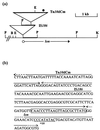lon incompatibility associated with mutations causing SOS induction: null uvrD alleles induce an SOS response in Escherichia coli
- PMID: 10809694
- PMCID: PMC94501
- DOI: 10.1128/JB.182.11.3151-3157.2000
lon incompatibility associated with mutations causing SOS induction: null uvrD alleles induce an SOS response in Escherichia coli
Abstract
The uvrD gene in Escherichia coli encodes a 720-amino-acid 3'-5' DNA helicase which, although nonessential for viability, is required for methyl-directed mismatch repair and nucleotide excision repair and furthermore is believed to participate in recombination and DNA replication. We have shown in this study that null mutations in uvrD are incompatible with lon, the incompatibility being a consequence of the chronic induction of SOS in uvrD strains and the resultant accumulation of the cell septation inhibitor SulA (which is a normal target for degradation by Lon protease). uvrD-lon incompatibility was suppressed by sulA, lexA3(Ind(-)), or recA (Def) mutations. Other mutations, such as priA, dam, polA, and dnaQ (mutD) mutations, which lead to persistent SOS induction, were also lon incompatible. SOS induction was not observed in uvrC and mutH (or mutS) mutants defective, respectively, in excision repair and mismatch repair. Nor was uvrD-mediated SOS induction abolished by mutations in genes that affect mismatch repair (mutH), excision repair (uvrC), or recombination (recB and recF). These data suggest that SOS induction in uvrD mutants is not a consequence of defects in these three pathways. We propose that the UvrD helicase participates in DNA replication to unwind secondary structures on the lagging strand immediately behind the progressing replication fork, and that it is the absence of this function which contributes to SOS induction in uvrD strains.
Figures

Similar articles
-
uvrD mutations enhance tandem repeat deletion in the Escherichia coli chromosome via SOS induction of the RecF recombination pathway.Mol Microbiol. 1997 Nov;26(3):557-67. doi: 10.1046/j.1365-2958.1997.6011973.x. Mol Microbiol. 1997. PMID: 9402025
-
Recombination is essential for viability of an Escherichia coli dam (DNA adenine methyltransferase) mutant.J Bacteriol. 2000 Jan;182(2):463-8. doi: 10.1128/JB.182.2.463-468.2000. J Bacteriol. 2000. PMID: 10629194 Free PMC article.
-
Mechanism and control of interspecies recombination in Escherichia coli. I. Mismatch repair, methylation, recombination and replication functions.Genetics. 1998 Oct;150(2):533-42. doi: 10.1093/genetics/150.2.533. Genetics. 1998. PMID: 9755187 Free PMC article.
-
Proteolysis in the SOS response and metal homeostasis in Escherichia coli.Res Microbiol. 2009 Nov;160(9):677-83. doi: 10.1016/j.resmic.2009.08.012. Epub 2009 Sep 10. Res Microbiol. 2009. PMID: 19747971 Free PMC article. Review.
-
The single-stranded DNA-binding protein of Escherichia coli.Microbiol Rev. 1990 Dec;54(4):342-80. doi: 10.1128/mr.54.4.342-380.1990. Microbiol Rev. 1990. PMID: 2087220 Free PMC article. Review.
Cited by
-
Proteomic survey of the DNA damage response in Caulobacter crescentus.J Bacteriol. 2023 Oct 26;205(10):e0020623. doi: 10.1128/jb.00206-23. Epub 2023 Sep 20. J Bacteriol. 2023. PMID: 37730540 Free PMC article.
-
Molecular mechanisms of collateral sensitivity to the antibiotic nitrofurantoin.PLoS Biol. 2020 Jan 27;18(1):e3000612. doi: 10.1371/journal.pbio.3000612. eCollection 2020 Jan. PLoS Biol. 2020. PMID: 31986134 Free PMC article.
-
The Escherichia coli dnaN159 mutant displays altered DNA polymerase usage and chronic SOS induction.J Bacteriol. 2004 Oct;186(20):6738-48. doi: 10.1128/JB.186.20.6738-6748.2004. J Bacteriol. 2004. PMID: 15466025 Free PMC article.
-
UvrD controls the access of recombination proteins to blocked replication forks.EMBO J. 2007 Aug 22;26(16):3804-14. doi: 10.1038/sj.emboj.7601804. Epub 2007 Jul 19. EMBO J. 2007. PMID: 17641684 Free PMC article.
-
Isolation of SOS constitutive mutants of Escherichia coli.J Bacteriol. 2004 Nov;186(21):7149-60. doi: 10.1128/JB.186.21.7149-7160.2004. J Bacteriol. 2004. PMID: 15489426 Free PMC article.
References
-
- Bierne H, Seigneur M, Ehrlich S D, Michel B. uvrD mutations enhance tandem repeat deletion in the Escherichia coli chromosome via SOS induction of the RecF recombination pathway. Mol Microbiol. 1997;26:557–567. - PubMed
-
- Blattner F R, Plunkett III G, Bloch C A, Perna N T, Burland V, Riley M, Collado-Vides J, Glasner J D, Rode C K, Mayhew G F, Gregor J, Davis N W, Kirkpatrick H A, Goeden M A, Rose D J, Mau B, Shao Y. The complete genome sequence of Escherichia coli K-12. Science. 1997;277:1453–1462. - PubMed
-
- Chan A, Nagel R. Involvement of recA and recF in the induced precise excision of Tn10 in Escherichia coli. Mutat Res. 1997;381:111–115. - PubMed
Publication types
MeSH terms
Substances
LinkOut - more resources
Full Text Sources
Molecular Biology Databases

